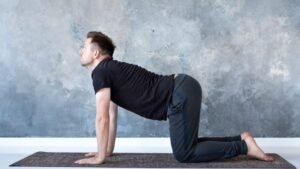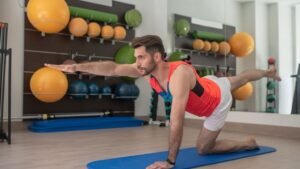Lower back pain is a common issue that affects millions of individuals worldwide. Whether it’s due to prolonged sitting, poor posture, or physical strain, finding effective ways to relieve and manage lower back pain at home is essential. Dr. Vigils specializes in providing expert physiotherapy for back pain, helping patients regain comfort and mobility through personalized care and physical therapy for lower back pain.
This blog introduces the top 5 exercises for lower back pain relief you can safely do at home. These exercises are geared towards strengthening, stretching, and stabilizing your lower back muscles, key components of effective back pain physiotherapy that can prevent future pain and improve quality of life.
Why Choose Physiotherapy for Back Pain?
Physiotherapy for back pain focuses on restoring movement and function while reducing pain by targeting the root causes, such as muscle weakness, stiffness, or improper biomechanics. Dr. Vigils offers advanced physiotherapy treatments tailored to individual needs, leveraging expert knowledge and techniques to manage both acute and chronic lower back conditions without reliance on surgery or medication.
Regular lower back pain exercises prescribed by physical therapy specialists promote blood flow, enhance muscle coordination, and reduce nerve irritation, all while ensuring gradual recovery without overexertion. Through Dr. Vigils’ clinical expertise in back pain physiotherapy, patients experience improved flexibility, strength, and overall spinal health.
1. Knee-to-Chest Stretch

The knee-to-chest stretch is a gentle yet effective exercise to relieve tension and pain in the lower back. It targets the lumbar muscles, helping to elongate and relax the area.
How to do it:
- Lie flat on your back on a comfortable surface.
- Slowly draw one knee toward your chest, holding the back of your thigh or shin.
- Hold this position for 20-30 seconds, feeling a gentle stretch in your lower back.
- Release and repeat with the other leg.
- Perform 3-5 repetitions on each side, two to three times daily.
This exercise promotes spinal flexibility and reduces muscle tightness common in lower back pain. Incorporating this into your routine as part of physical therapy for lower back pain practice can greatly enhance your recovery and pain relief.
2. Pelvic Tilts

Pelvic tilts are foundational lower back pain exercises that strengthen your abdominal muscles and mobilize the spine gently.
How to do it:
- Lie on your back with your knees bent and feet flat on the floor.
- Engage your core by pulling your belly button gently towards your spine.
- Flatten your lower back against the floor by tilting your pelvis upward.
- Hold for 5 seconds, then release.
- Repeat 10-15 times for 2-3 sets daily.
This exercise supports spinal alignment and strengthens the muscles that stabilize your lower back, making it a key part of physiotherapy for back pain regimens. Dr. Vigils integrates this into customized back pain physiotherapy plans to help patients regain core stability and reduce strain on the lower back.
3. Cat-Cow Stretch

The Cat-Cow stretch is a yoga-inspired movement that increases flexibility and mobility in the spine, helping to relieve stiffness associated with lower back pain.
How to do it:
- Start on all fours with your wrists under your shoulders and knees under your hips.
- Inhale, arch your back by dropping your belly toward the floor, lifting your head and tailbone (Cow Pose).
- Exhale, round your spine toward the ceiling, pulling your belly button up and tucking your chin to your chest (Cat Pose).
- Repeat slowly for 10 cycles.
This dynamic spinal stretch relieves muscle tension and aligns the vertebrae, making it excellent for physical therapy for lower back pain. Dr. Vigils emphasizes this exercise because of its ability to enhance spinal function with minimal risk.
4. Bird-Dog Exercise

The bird-dog exercise improves lower back stability by activating the core and gluteal muscles, which support the lower spine.
How to do it:
- Begin on your hands and knees, keeping the back flat.
- Tighten your abdominal muscles.
- Slowly extend your right arm forward and your left leg backward, maintaining balance.
- Hold for 10-15 seconds, then return to the starting position.
- Repeat on the opposite side, performing 5-10 repetitions per side.
This exercise is fundamental in back pain physiotherapy to improve coordination and strength. Dr. Vigils includes it in rehabilitation programs aimed at preventing recurrent lower back pain episodes.
5. Lumbar Rotation Stretch

This stretch gently mobilizes the lumbar spine and relieves lumbar muscle tightness.
How to do it:
- Lie on your back with knees bent and feet flat.
- Keep your shoulders against the floor.
- Slowly rotate your bent knees to one side as far as comfortable.
- Hold the position for 20 seconds, then return to the center.
- Repeat on the opposite side, performing 5 repetitions on each side.
Lumbar rotation helps ease stiffness and increase fluidity in spinal movement, which is essential in physical therapy for lower back pain. Dr. Vigils recommends this to patients experiencing muscle tightness or minor stiffness.
How Dr. Vigil’s Enhances Your Recovery with Physiotherapy for Back Pain
Dr. Vigils’ approach to physiotherapy for back pain combines expertly guided exercises with personalized treatment strategies. Their range of services includes manual therapy, electrotherapy, postural correction, and exercise prescription, designed to target the underlying causes of pain rather than just symptoms.
Patients receive:
- Comprehensive assessments to tailor physical therapy for lower back pain or physiotherapy for back pain specifically to their condition.
- Supervised exercise programs that include the above-mentioned lower back pain exercises.
- Guidance to safely progress with exercises for sustained relief and improved mobility.
- Education on ergonomic practices and lifestyle modifications to prevent recurrence.
Back pain physiotherapy at Dr. Vigils is a holistic experience that empowers patients to actively participate in their healing journey, reducing dependency on medications or invasive procedures.
Conclusion
Lower back pain can be challenging to manage alone, but with the right exercises and professional physiotherapy for back pain, it is possible to alleviate discomfort and regain functional movement. The exercises outlined above offer a balanced approach to strengthening, stretching, and mobilizing the lower back at home.
For those seeking expert guidance schedule appointment at, Dr. Vigils provides advanced physiotherapy for back pain with personalized treatment plans that incorporate these exercises into a broader recovery strategy. This ensures not only short-term pain relief but also long-term spinal health and prevention.
Commit to these lower back pain exercises as recommended by Dr. Vigils, and take a step closer to a pain-free life.




